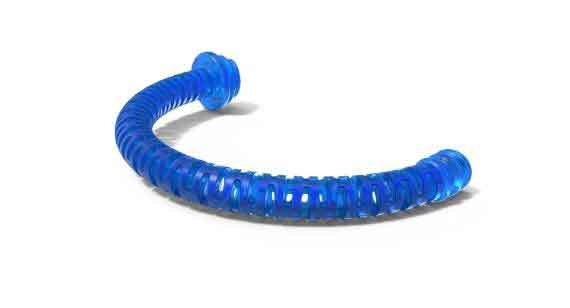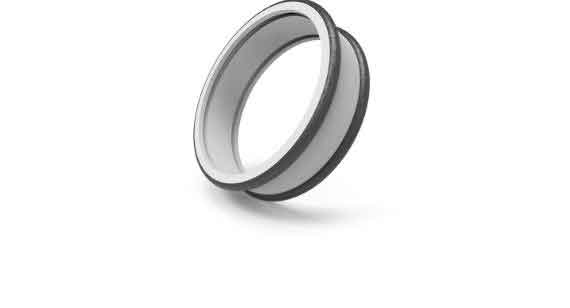Minimizing Creep and Stress Relaxation in Elastomeric Parts
In the universe of manufacturing materials, elastomers are polymers characterized by weak intermolecular forces. This weakness is useful in that it allows the material to change shape when subjected to external force and then return to its original form when the force is no longer applied. This characteristic makes elastomers ideal for the production of seals, gaskets, and springs of various sorts when using injection molding or 3D printing.
Functioning as a seal or gasket, a part made of elastomer changes shape as force is applied. It takes up slack between adjoining parts, filling gaps or irregularities as pressure is applied and keeps a gas or liquid from leaking. A rubber band is a familiar example of an elastomer subjected to tensile forces. Another is the soft plastic bumper on a cellphone case, which when subjected to a compressive force of a drop or blow deforms to protect the phone from shock, and then returns to its “free” or unstressed state. In both compressive and tensile spring applications, a part made of elastomer acts very much like a coil or leaf spring made of metal.

Elastomeric parts can be used in either static or dynamic applications. An O-ring used as a dust seal or alignment aid typically is a static application in that once the assembly has been completed, there is no movement of the O-ring or adjacent parts.
In a dynamic application—the lid seal on a pressure cooker for example—the elastomer is compressed and released repeatedly during normal use. In an even more extreme case, the elastomeric sole of a running shoe is compressed and released with every step. The lifespans of these parts vary, but they are all subject to creep.
Creep: When Recovery is Less Than Perfect
It may not be obvious, but elastomeric parts will gradually lose their elasticity and fail to return (or attempt to return) to their unstressed state. Creep, this progressive loss of elasticity, can begin with a part’s very first use and continue through its useful life.
A familiar example is the rubber band that does not fully regain its original dimensions when released. This is creep due to mechanical stress, but it is not the only way creep can occur. Think about the rubber band you find on a stack of photos in an old shoebox in the attic. Simple age and exposure to the environment has left it limp; it may even crumble when handled.
How extreme this loss of elasticity is and how quickly it occurs depends on a number of factors. Repetitive mechanical stress is the reason that active runners have to replace their shoes periodically when the soles lose the ability to absorb shock. Your car engine’s head gasket is a purely static application; nevertheless it will need periodic replacement due to material breakdown caused by the heat of combustion and the resulting expansion and contraction. Over time this creates wear, and ultimately failure, of the seal. The tiny elastomers in your TV remote can be broken down by UV radiation coming in a sunny window. And the gaskets in a pressure cooker are affected by mechanical stress, the high heat of pressure cooking, the acids in some foods, and impurities in cooking water. It may take years, but each of these parts will eventually experience stress relaxation.

Stress Relaxation: The End of the Line
A well-designed elastomeric part can experience creep over its entire life. Stress relaxation, on the other hand, occurs when cumulative creep renders the part no longer functional. When your garden hose starts leaking at the faucet, it’s probably because the little gasket inside the hose connector no longer fully fills the gap between the metal of the faucet and the metal hose-end fitting. When your engine’s valve cover starts leaking oil, stress relaxation has probably compromised the valve cover gasket’s ability to seal the joint between the valve cover and the head.
But use isn’t the only cause of stress relaxation. Elasticity can be lost due to underuse. In fact, elastomeric parts in inventory can actually become brittle just sitting on a shelf.
Stress relaxation occurs when a seal or gasket no longer fully fills the space between mating surfaces. Air or other gases will be most prone to leakage around a seal, and are able to pass through a gap as small as 0.001 in. (25.4mm). Liquids, being more viscous, will need a wider gap to leak through, though fuel will leak through a narrower gap than water. Similarly, an elastomer spring approaching a state of stress relaxation will weaken and lose the ability to work through its entire intended range of motion.
Minimizing the Impact of Creep
Creep is a fact of life for elastomeric polymers, but there are several ways to reduce potential consequences.
- Choose the best elastomer for the job. Evaluate the application and determine whether the part will be flexed repeatedly. Will it be subject to repeated extreme temperature variations including both heat and cold? Will the material be exposed to corrosive chemicals or UV radiation?
- Design parts to handle anticipated stresses. A typical elastomer in a static application can handle 20 percent compression without undue shortening of its useful life; the same elastomer, in a dynamic application, should typically be kept below 10 percent compression. You may want to increase a part’s size to keep its degree of compression within an acceptable range for the application.
- Know the life expectancy of your elastomeric part. Include elastomer replacement in the product’s maintenance schedule and offer replacement kits.
- If possible, avoid long-term stockpiling of replacements to prevent shelf wear that can shorten part life. On-demand production can make parts available as needed without wasting part of their useful life in storage.
Final Thoughts on Elastomers
Elastomers can be simple, effective components in a variety of spring and sealing applications. Be aware that, despite having no moving parts, they can wear out. Thoughtful design and careful testing can maximize their useful life. By knowing the life expectancy of those parts and offering replacement parts, you can reap the full benefits of these simple, effective components while maximizing the life and functionality of your finished product.
Our Material Comparison Guide provides more detailed information on elastomeric materials.
To get your next design project started today at China Metal Parts, simply upload a 3D CAD model for an interactive quote within hours.